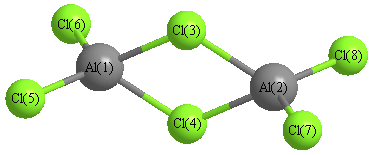Vibrational Frequencies calculated at CCD/3-21G
| Mode Number |
Symmetry |
Frequency
(cm-1) |
Scaled Frequency
(cm-1) |
IR Intensities
(km mol-1) |
Raman Act
(Å4/u) |
Dep P |
Dep U |
|---|
| 1 |
Ag |
495 |
481 |
0.00 |
|
|
|
| 2 |
Ag |
313 |
305 |
0.00 |
|
|
|
| 3 |
Ag |
215 |
209 |
0.00 |
|
|
|
| 4 |
Ag |
91 |
89 |
0.00 |
|
|
|
| 5 |
Au |
61 |
59 |
0.00 |
|
|
|
| 6 |
B1g |
596 |
580 |
0.00 |
|
|
|
| 7 |
B1g |
103 |
100 |
0.00 |
|
|
|
| 8 |
B1u |
366 |
356 |
186.37 |
|
|
|
| 9 |
B1u |
121 |
118 |
20.30 |
|
|
|
| 10 |
B2g |
241 |
234 |
0.00 |
|
|
|
| 11 |
B2g |
151 |
147 |
0.00 |
|
|
|
| 12 |
B2u |
607 |
591 |
262.94 |
|
|
|
| 13 |
B2u |
170 |
165 |
24.77 |
|
|
|
| 14 |
B2u |
23 |
22 |
0.55 |
|
|
|
| 15 |
B3g |
119 |
115 |
0.00 |
|
|
|
| 16 |
B3u |
455 |
443 |
386.50 |
|
|
|
| 17 |
B3u |
297 |
288 |
108.94 |
|
|
|
| 18 |
B3u |
131 |
128 |
33.01 |
|
|
|
Unscaled Zero Point Vibrational Energy (zpe) 2277.5 cm
-1
Scaled (by 0.9723) Zero Point Vibrational Energy (zpe) 2214.4 cm
-1
See section
III.C.1 List or set vibrational scaling factors
to change the scale factors used here.
See section
III.C.2
Calculate a vibrational scaling factor for a given set of molecules
to determine the least squares best scaling factor.
